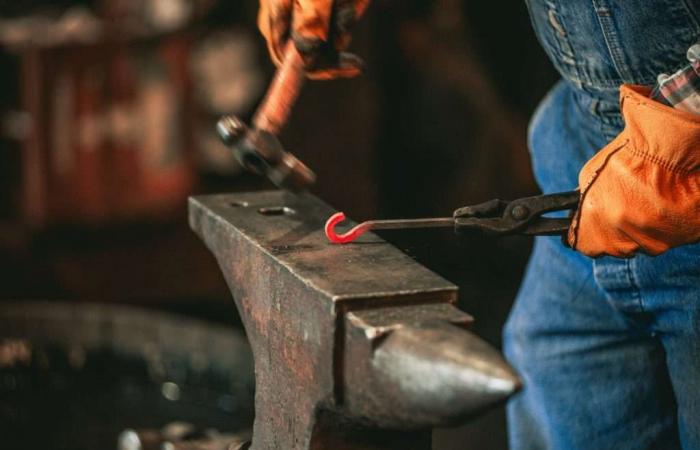If we think of a metal, a gray iron bar, solid, resistant and hard, probably comes to mind; But metals are much more than a group of chemical elements “good conductors of heat and electricity, with a characteristic shine, solid at ordinary temperatures, except for mercury,” as dictionaries define them.
The history of metallic elements and that of Humanity are closely intertwined and “knowing metals is as much as knowing ourselves. Rediscovering them not only opens the doors to the depths of the past, culture and human nature, but also to their future,” says scientist and researcher Álvaro Martínez Camarena.
He assures that “all human disciplines, from politics, religion and superstitions to medicine, history, technology and art, are connected to each other and that one of their most important points of union is a group of metals that “They have accompanied us since we took our first steps as a species.”
Martínez Camarena (Valencia, Spain, 1992; @AlMar_Supra) is a doctor in Nanoscience and Nanotechnology and professor of Inorganic Chemistry at the Complutense University of Madrid; He has received various awards for his academic and scientific dissemination career, and is the author of the book ‘History of the metals that changed the world’.
Seven ancient metals (gold, silver, copper, lead, tin, iron and mercury) have determined and determine the way we see, understand and represent the world, while others (the ‘rare earths)’ are decisive for our future, as they are essential for technological and energy development, as explained in an interview with EFE.
— In your book you point out that gold is synonymous with power and has been used by most religions. Why is this happening?
Dr. Martínez Camarena responds that gold is one of the metals known since Antiquity, which is characterized by having unusual properties.
“It is the only metal capable of resisting any condition to which we want to subject it (as long as we do not put it in a chemical reactor, of course), and it also does not rust, lose its shine, or corrode,” as he explains. .
On the other hand, “it is a very beautiful metal, with an unusual color and luminosity; and it is also very rare to find,” he points out.
He notes that “what little gold there is on Earth probably came from a meteor shower that took place about four billion years ago.”
“These physical and chemical properties, in addition to its condition as a scarce resource, have meant that from very early on almost all religions linked this metal with divinity,” he points out.
— He also points out, in his informative work, that organic farming uses metal salts to avoid pests in crops. What does this use consist of?
Martínez Camarena points out that “it is quite unknown to what extent metals play a crucial role in biology in general, and in the functioning of our organism in particular.”
“There are thousands of types of proteins and biological systems that depend entirely on metals such as iron, copper, zinc or nickel, but these same elements can be toxic in ridiculously small quantities to other organisms, just like mercury. It is for humans,” he asserts.
This scientist gives as an example the case of copper, which “is very useful in our metabolism, among other things to eliminate toxic compounds that can cause serious damage, such as those known as ‘reactive oxygen species’.”
He explains that copper is an essential metal for people and is toxic only in relatively high concentrations.
“However, for a large number of bacteria, fungi and other organisms responsible for the generation of pests in crops, this metal is toxic at almost any concentration,” he points out.
“This is why in part of organic farming this metal is used as a ‘natural pesticide’, although it must also be said that its use is discouraged, because it can contaminate aquifers (subterranean bodies of water) and cause ecological problems much greater than those that its use is intended to solve,” says this specialist.
— He has commented that certain metals are behind the great interest that a former American president, China and the fortunes of Silicon Valley have shown in conquering Greenland, which is a wasteland of ice and snow. Why are they so interested?
“Under the soil of this Arctic island, the largest unexploited deposits of ‘rare earths’ that exist on our planet are hidden,” says Martínez Camarena.
He explains that these ‘rare earths’ are a series of strategic metals that are essential for the functioning of our technology, as well as for the energy transition and the transformation aimed at a sustainable and digital economy in which we are immersed.”
“These metals are essential for the turbines of wind turbines, the motors of electric vehicles (cars, buses, trains), magnetic resonance equipment in hospitals and smartphones to function,” as he lists, emphasizing that none of them These systems could work without ‘rare earths’.
“As if that were not enough, some of the large consumers of electrical devices, such as the countries of the European Union, barely have deposits from which to obtain these metals, so the control of ‘rare earth’ mines is of utmost importance. at a geostrategic level,” he points out.

— He has also revealed in his research that copper was capable, by itself, of putting an end to some periods of human history. How did this phenomenon occur?
Martínez Camarena points out that “copper has played a leading role in the history of humanity, especially during certain periods of prehistory.”
“The discovery of this metal and some of its alloys, such as bronze (copper with tin, in most cases), produced profound changes in prehistoric societies, at a technological, social and economic level,” he points out.
“With copper and bronze, tools of a much higher quality were produced, from weapons to nails and needles,” according to this expert.
But the transformation was much more profound, because “when metallurgy was created, there was a specialization of work and an increase in social differences within groups, and also increased trade between territories and towns separated by great distances: between those who had of copper and tin deposits, and those who needed these metals,” he adds.
— In your book, do you predict that another of the metals considered ‘precious’, silver, will become our key tool to defeat the pandemics of the future? Could you explain it?
Martínez Camarena points out that “although we usually see it as an ornamental metal, silver has been used for medical purposes since ancient times.”
“For example, doctors learned in the mid-19th century that if surgical wounds were sutured with silver thread, they were less likely to become infected. In fact, its use for this purpose continues to this day,” he notes.
He highlights that “silver continues to be used in hospital materials, which in many cases are made or coated with this metal, from intravenous catheters to ulcer dressings, surgical instruments and urinary catheters. And it is also present in the water purification systems themselves to eliminate Legionella bacteria.”
“All this has to do with a peculiar property of silver: its ability to eliminate bacteria. Now, this characteristic is being studied as a tool to combat with extremely small silver particles (nanoparticles), one of the most worrying future threats to our society: superbacteria,” he concludes.
Daniel Galilea.
EFE – Reports



